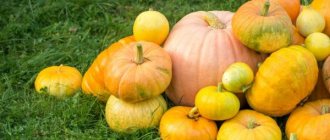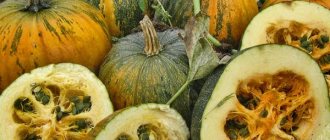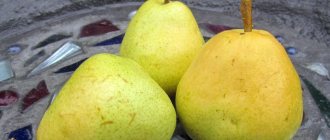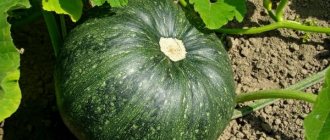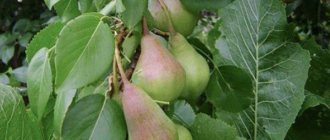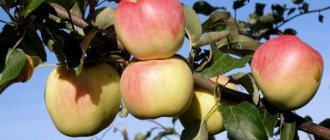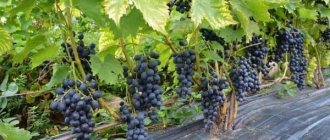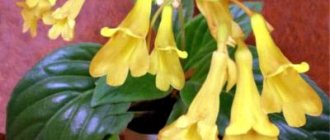» Vegetable growing » Pumpkin » Red Riding Hood pumpkin
0
953
Article rating
Decorative pumpkin Red Riding Hood is an annual plant. The fruits have the outline of an eastern headdress - a turban, which is why the variety is called turban-shaped.
Turban pumpkin Little Red Riding Hood
Description and characteristics of the variety
Outwardly, this variety of pumpkin from the turbanaceae family cannot be confused with any other. One of the features of the plant is its long tendrils, which make it possible to grow the crop on vertical supports.
Productivity
The Red Riding Hood variety is high-yielding. The plant is capable of producing more than 10-20 fruits from each bush weighing 2-5 kg.
Fruit characteristics
Externally, the vegetable looks like a mushroom with a red cap that resembles a turban. Below, the fruit has fairly clear edges with smoothed corners. The pulp is orange-yellow, bright. The taste is sweet, slightly reminiscent of melon, with a nutty aftertaste.
The weight of one decorative pumpkin “fungus” is about 2 kg, but you can grow pumpkins weighing 4-5 kg. The base of the fruit is light, cream-colored, sometimes with green inhomogeneous longitudinal stripes.
Pictured is the Little Red Riding Hood pumpkin:
Features of cultivation
Despite its unpretentiousness and adaptation to various growing conditions, agricultural technology for cultivating decorative pumpkins has its own characteristics.
Selecting a location
For planting, it is better to choose sunny or slightly shady places. Only in this case will the pumpkin vines actively grow, and the fruits will gain color saturation and show all their decorativeness.
See also
Description of the early ripening and productive vegetable squash UFO and agricultural cultivation techniques
Read
Preparation of planting material and growing seedlings
Before sowing, the seeds must be germinated. After soaking in water with a growth stimulant added, they are wrapped in a damp cloth and placed in a warm, dark place. Then the hatched seeds are placed in glasses filled with substrate with a volume of at least 0.5 liters. The depth of the planting holes for planting is 4-5 centimeters. Seeds for seedlings are sown in the second half of April-early May, depending on the growing region.
Planting process
Seedlings are planted in open ground in early June. The seedling is carefully taken out, turning the glass over, and placed in a pre-prepared hole. Then sprinkle with earth and water well. A slight burial of seedlings during planting is allowed. Sowing simply in open ground is carried out from the second half of May. The distance between planting holes is 30-50 centimeters.
Is it possible to eat decorative pumpkin?
Many, seeing a pumpkin in the form of a mushroom with a red cap, ask the question: “Is it possible to eat it?” Turban-shaped is a decorative, not a culinary variety. However, the young fruits of Little Red Riding Hood, unlike its bitter-tasting counterparts, are edible. It is eaten raw, stuffed, added to salads, stewed, fried and boiled.
Important ! You can only eat vegetables with soft and thin skin. As the pumpkin grows, it becomes hard and unsuitable for food.
Productivity and taste
The variety is characterized by high productivity. From each bush you can collect:
- 10 or more fruits weighing 4-5 kg;
- 20 or more fruits weighing 3 kg.
Unlike other ornamental species with a bitter aftertaste, Red Riding Hood is suitable for consumption for food purposes. Salads are prepared from it, boiled, stewed and fried. It can also be eaten raw.
The structure of the pulp is sugary and crumbly. It is sweet, with a nutty-melon aftertaste. There is no unpleasant astringency. In terms of gastronomic qualities, it resembles the best varietal muscat varieties.
Young vegetables have the richest taste and softness. In a more ripe state, the fruits become hard. Such specimens are often used to decorate home interiors.
How to grow
The variety is planted in the spring, after frosts. Seeds can be sown directly into the ground or seedlings can be prepared first. The difference will be in the timing of flowering and ripening - pumpkin seedlings will ripen and bear fruit faster.
It is recommended to plant the crop on the sunny side, next to some kind of support. For decorative purposes, gardeners sow it near the fence. Over time, the red cap begins to weave along the fence, forming a hedge.
Features of cultivation
To get a good harvest of decorative pumpkin, you should know the features of its cultivation. Little Red Riding Hood has quite a few of them:
- Vegetable crops are not picked . Transplantation begins in June. The planting scheme is as follows: the distance between plants is 0.3 m, the depth is no more than 0.3 m. The recommended distance between rows is 0.2 m.
- The turban-like culture prefers fertile soil with neutral acidity. Grows well and bears fruit on manure fertilizers. The rate of application of cow manure is 50 kg per 10 m².
- After planting, the plant is covered with film, creating a greenhouse effect. When the air warms up to 20 degrees, the film is removed. The vegetable begins to grow actively at a temperature of 30 degrees.
- It is necessary to shape the plant. Pinching begins when the lashes reach a length of 1 m.
- Turban-like grows poorly after sunflowers, watermelons, and potatoes. It is worth refusing to be adjacent to other large-fruited varieties. Red cap is best grown in complete isolation with artificial pollination.
Pumpkin Little Red Riding Hood: watering and fertilizing
The Red Riding Hood pumpkin variety was created by American breeder Luther Burbank. The base is Chilean acorn squash. The breeder carefully selected fruits and seeds to obtain a fruit with certain characteristics. The culture is considered decorative, but it is consumed as food.
It is distinguished by sweet and juicy pulp. Vegetables are used for portioned preparation of dishes. What are the characteristics of this culture? What kind of care does it require?
Description of the variety
The Red Riding Hood variety belongs to the group of turban-shaped pumpkins. It is also called “turban” or “mushroom”. A pumpkin looks like a mushroom, has 2 parts, a stem and a cap.
The leg is light gray in color with a ribbed surface. The cap is red or deep orange. Vegetables look unusual in the garden and will truly decorate your garden plot:
- early culture. Technical ripeness occurs after 100 days. This is not a hybrid plant, so the fruits can be left to ripen to produce seeds;
- The average weight of a vegetable is 2 kg, but fruits from 500 g to 5 kg can ripen on one bush. Cooks use small pumpkins instead of ceramic pots for preparing pilaf, roast, vegetable dishes and porridges;
- The flesh of the Little Red Riding Hood pumpkin is thick, up to 10 cm. The color is orange. The pulp has a nutmeg texture, low in juiciness, but very sweet, with a high carotene content. It tastes like melon;
- the seed chamber is small, but the seeds are large. The core is covered with an orange dense shell with a rim;
- The bush is spreading and produces many long vines. If the vines are not pinched, the fruits grow small, weighing no more than 500 g. There are many of them on the bush, more than 20 pieces. To obtain a larger pumpkin, pinch the stems, leaving no more than 3-4 ovaries on each;
- the crop is grown in all regions, both in open ground and in greenhouse conditions;
- vegetables grow well in loamy, loose and fertile soil;
- Gardeners value the Red Riding Hood variety not only for its external, decorative characteristics, but also for its resistance to cercospora and powdery mildew. The plant is cold-resistant and can tolerate light frosts. It is unpretentious in care.
More on the topic: What color can a pumpkin be?
In the southern regions, Little Red Riding Hood is grown from seeds. They are laid in open ground. The optimal soil temperature is 8-10 C. In the northern regions, vegetables are grown from seedlings.
Gardeners note that the Little Red Riding Hood pumpkin tolerates being kept under film well.
It is not pollinated with other crops, which allows you to obtain vegetables with certain, stable characteristics.
For turban-like crops, greenhouse cultivation is most preferable, but artificial pollination is necessary. Otherwise, the plant will go into foliage. Ovaries do not appear on the stems.
Greenhouses are being built for them. The optimal air temperature for seedlings is 15-18 C. They are covered with a film tunnel to protect them from precipitation and possible frosts.
When to plant?
For vegetables, choose a sunny area in the garden. If there is no greenhouse, then the bed is located away from other plants of the pumpkin family.
In the fall, rotted compost, ash and sand are added to it. It is recommended to scatter Nitrophoska throughout the garden bed to prevent insects from emerging from the soil in the spring. Dig up the bed using 2 shovels.
In the spring, before harrowing the bed, mineral fertilizers, potassium chloride, superphosphate and ammonium nitrate are scattered on it. Treat the soil with Bordeaux mixture. The land is harrowed and covered with film so that it warms up better.
Sowing is carried out when the soil warms up to the optimal temperature, at the end of April, in mid-May. The same deadlines are observed when growing pumpkins in greenhouse conditions. If there is no greenhouse or greenhouse, then the sowing date is postponed until mid-June.
Seedlings are planted in an open area in mid or late May in the southern regions, and in mid or late June in the northern regions. It is grown at home or in heated greenhouses.
Seedlings adapt to weather conditions faster if they are pre-hardened. 2 weeks before the planned planting, the seedlings are taken out to the garden plot for a short time. Gradually, the duration of hardening is increased, bringing it to 24 hours. It is recommended to water the soil in individual cups with the preparation “Siyanie-1”. This is a good prevention against diseases of the root system.
Sowing of seedlings is carried out in individual cups; Little Red Riding Hood pumpkin does not tolerate picking well. Duration of cultivation is 30 days. Planting on a permanent bed is carried out when 4 leaves develop on the bush.
More on the topic: What complementary foods do you need for pumpkin?
How to care?
Caring for the Little Red Riding Hood pumpkin is standard. It needs to be watered regularly, loosen the soil, and weed. If the plant does not develop well enough, then fertilizing is introduced.
Only mineral fertilizers are used. A solution of mullein and bird droppings will provoke intensive growth of tops and deformation of the fruit. It is recommended to treat plants against insects and fungal infections.
Water the pumpkin once every 10 days, but do not allow the soil to become waterlogged or overdry. Weather conditions are always taken into account. It is easier to arrange watering in a greenhouse. The bed is protected from precipitation.
If the soil is too dry, then heavy watering is not recommended. A pumpkin that receives a large amount of liquid at once may burst. The soil is moistened gradually, bringing the volume of water to normal:
- for young seedlings, no more than 2 liters of water per bush is required. Surface watering is often carried out using a watering can. In this case, 1 m2 will require up to 5-6 liters;
- when the plant begins to bloom, the volume of water is increased to 5 liters per bush;
- if fruits appear on the stems, then the amount of liquid is increased to 12 l;
- 2-3 weeks before technical ripening, watering is stopped, but it is not recommended to overdry the soil.
The dry earthen crust on the soil must be destroyed so that the roots receive air and develop normally. Before 6-8 leaves appear, the bushes are earthed up.
To retain moisture in the garden bed, mulching is carried out. It could be sand, sawdust, hay. The mulch is turned over regularly. Otherwise, slugs will settle in it.
Little Red Riding Hood pumpkin produces long stems. They can be pinned or covered with soil. The sprinkled vine begins to take root, holding onto the soil with its tendrils. The plant develops better and receives enough nutrients for full fruit growth. It is recommended to constantly adjust the direction of the stems so that the pumpkins do not fall into the shade or into the beds of other plants.
Once a month, plants are treated against infectious diseases. With precipitation and wind, the powdery mildew virus can spread to them. Little Red Riding Hood pumpkin is resistant to this infection, but gardeners recommend playing it safe.
After each rain cycle, use Actellik, 3 ml/l; spraying the bushes. For fungal diseases, it is recommended to treat the pumpkin with Topaz; 1 ampoule is diluted in 10 liters of water, and the plants are irrigated from a spray bottle.
More on the topic: What care does the Smile pumpkin require?
“Aktara”, 1 tsp, helps well against insect pests. for 5 l. To prevent slugs from settling on the bushes, use boric acid, table salt or red pepper infusion.
After each treatment of plants with chemicals, it is recommended to introduce fertilizer from a solution of weeds and yeast. This is a nutrient solution. It is often used to increase the immunity of seedlings and to improve the taste characteristics of the pulp.
Fertilizers with mineral fertilizers are used according to a certain scheme. They must solve specific problems. To better form the root system, use potassium salt, 20 g/10 l and superphosphate, 40 g/10 l. You can introduce mineral complexes, such as “Zdraven”, “Kornevin”.
Before the formation of ovaries, the plants are fed with a solution of weeds and yeast. You can use Iron Hilak, boric acid, magnesia. Boron, iron, magnesium improve fruit development and increase productivity.
If the pumpkin was sown at the end of April, then young shoots will appear at the end of May. With normal crop development, the harvest can be harvested as early as mid or late August.
When planting seedlings at the end of May or mid-June, vegetables are harvested in September. Pumpkin can be stored at home for more than 6 months. Its skin becomes very dense and woody. It prevents the evaporation of moisture from the pulp.
Source: https://GoFerma.ru/ovoshhevodstvo/tykva/kakogo-uhoda-trebuet-tykva-krasnaya-shapochka.html
Prevention of diseases and pests
Infection of a plant and the appearance of pests on it is easier to prevent.
For prevention purposes, it is recommended to carry out a number of agrotechnical measures:
- Follow the rules of crop rotation. Pumpkin crops are not planted in the same place more than once every 3-4 years.
- Carry out deep plowing with fresh manure.
- Maintain distance between plants. Do not thicken the plantings.
- Do not cultivate melons (zucchini, melons, cucumbers) nearby.
- Weed regularly. They contain fungal spores.
- Feed the pumpkin with complex mineral fertilizers (copper sulfate, boric acid with urea, potassium permanganate, zinc sulfate).
- Regularly inspect plantings for diseases and pests.
- Promptly remove infected plants and fruits.
- Plant residues after harvesting should be carefully removed from the field and burned.
Good care in most cases prevents plant diseases and insect damage. But if trouble does happen, you can’t hesitate.
To control pests, it is recommended to use herbal remedies or folk remedies that are harmless to humans. You should only resort to toxic chemicals in extreme cases.
Pulp
Fragrant pumpkin pulp is rich in vitamins.
It also contains ascorbic acid, which will save you from autumn colds, and B vitamins, which will not only cope with fatigue, irritability and insomnia and get rid of acne, but will also make your hair lush and your nails strong, and vitamins A and E - the main fighters against wrinkles and premature aging, and vitamin K, which affects blood clotting, which is practically absent in other vegetables. Thanks to the high content of rare vitamin T, pumpkin can rightfully be called the best side dish for beef, pork and other fatty dishes, because vitamin T promotes the absorption of heavy foods and prevents obesity. Probably, it is precisely for this property that nutritionists love pumpkin so much, who recommend leaning on the healthy vegetable to everyone who has long dreamed of losing extra pounds. In addition, pumpkin is the champion among vegetables in terms of iron content, which means that pumpkin lovers are doomed to have a good complexion and a cheerful mood. It is believed that pumpkin juice helps men maintain sexual tone. However, experts assure that with the help of pumpkin you can not only solve problems on the personal front, but also cope with many serious diseases. There is perhaps no healthier food for people suffering from cardiovascular diseases. Due to its high potassium content, pumpkin improves heart function, strengthens blood vessels and relieves swelling.
Harvest and storage
Harvest before the first frost - in September-October. For gastronomic purposes, vegetables are cut unripe so that they do not have time to become tough. During the ripening process, the taste improves. However, the longer the fruits lie, the harder they will become. So, by spring they become so hard that they are suitable for making dishes.
At home, Little Red Riding Hood lies for about a year. To prevent pumpkins from spoiling for a long time, they are cut with a foot no shorter than 5 cm.
Advice ! For planting next year, the seeds are stored in the fall. The ideal place for this is wet sand. Store seed in the refrigerator or on a closed balcony.
Seeds
Pumpkin seeds are one of the richest sources of unsaturated fatty acids. Namely, these acids reduce the level of harmful cholesterol in the blood and protect the heart and blood vessels. In addition, pumpkin seeds are vitamin D - necessary for strong bones and the absorption of calcium by the body, zinc - without it there cannot be a good complexion, healthy hair, strong nails and strong immunity, magnesium - necessary for the coordinated functioning of the heart and nervous system, Helps build muscle and normalize blood pressure.
The seeds also improve appetite and accelerate wound healing. Lovers of natural cosmetics make homemade scrubs from them. The seeds are crushed, mixed with sour cream and applied to the face with massaging movements. After this procedure, the skin becomes surprisingly smooth. Well, psychologists recommend gnawing seeds for those who cannot quit smoking. It is believed that the process of peeling can suppress the craving for a cigarette. However, seed lovers need to be aware that during the frying process, most of the beneficial substances contained in the seeds are destroyed. Therefore, it is much better to simply dry them slightly rather than fry them.
Reviews from gardeners
Most gardeners note in this variety its unpretentiousness in cultivation and versatility in use. There are no negative reviews about the variety. Judge for yourself:
Yuri : “This pumpkin is cold-resistant, resistant to powdery mildew, and drought-resistant. It is early ripening, sweet, productive. From one plant I collect up to 30 fruits weighing 3-5 kg. The plants are quite compact, the length of the vines does not exceed 3 m. Having reached a certain weight on the vine, the fruits then ripen safely in storage. The bulk of the fruits ripen in December-January when usually stored on the floor in the room. It is during this period that their taste is irresistible. The first fruits ripen much earlier.”
Irina : “What’s interesting is that turban-shaped pumpkins can be stored at home for more than a year. The seeds of these pumpkins are healthy, with a lot of oil. Jam or candied fruits from turban-shaped pumpkins are transparent amber in color. When the pumpkin skin is still soft, you can stuff it with meat, vegetables and stew it in sour cream. But in a mature state they become inedible, with a thick crust. In spring, the pumpkin hardens, becoming suitable only for making vases.”
Faina : I usually plant “Little Red Riding Hood” turban pumpkin with seeds. Although the pumpkin’s weight is small, it has tasty and sweet, bright orange pulp with a melon aroma. The fruits are rich in carotene. I like to bake pumpkin slices and make porridge from it.”
Varietal advantages
Among the advantages of growing the Red Riding Hood turban is its cold resistance. The plant shows good resistance to low temperatures. It tolerates dry periods equally well, surviving for a long time without additional watering.
Seeds retain quality germination characteristics for 7 years or more.
Positive characteristics also include high immunity to one of the most common diseases - powdery mildew.
The plant is easy to care for
The plant is unpretentious in care. Through long tendrils it can grow to a height of several meters, acting as a decorative decoration in the landscape design of a personal plot for vertical or horizontal gardening.
It has an average ripening period: the first pumpkin harvest is harvested 90-100 days after the appearance of the first shoots.
The most popular varieties
Let's get acquainted with the fruits of common varieties of decorative pumpkins:
Mandarin
Lives up to its name. They are just as small, orange, round in shape, weighing up to 300 g .
Read also: DIY topiary trunk
Baby Boo
White pumpkins grow up to 10 cm in diameter . They have a smooth crust and are considered edible.
Sweet Dumpling
The fruits of the variety reach 500 g and look very original. Pumpkins with yellowish or white ribs , between which there are dark stripes with white specks.
Bischofsmutzen
Surprises with pumpkins from two hemispheres . Half of the skin is white, and the other half is green or red;
Kleine Bicolor
By the end of summer, the plant of this variety surprises with small pears, painted in two colors. Below - dark green with yellow stripes, above - yellow . The plant belongs to the group Lagenaria siceraria (bottle lagenaria).
Cou-Tors Native
A variety of torticollis, among the foliage there are fruits - swans with a bubbly, sunny orange shell .
They call it the shape of a pumpkin:
- warty , having a pear-shaped or round shape with wart-type outgrowths, varying in color;
- star-shaped , with a maximum diameter of up to 15 cm, flattened or elongated, varied colors, several colors are possible in one specimen;
- pear-shaped , pear-shaped pumpkins, up to 12 cm in size, on two-colored ones there is a clear boundary between the colors;
- vicofolia , the leaves of which resemble blades, with green fruits with a milk-colored or speckled stripe, round in shape;
- turban-shaped , in Russia such decorative zucchini is called “mushrooms”, tangerine or marble green in color;
- bottle , gourd or lagenaria, the fruits are colored green marble.
Peel
Compared to pulp and seeds, pumpkin peel contains much more zinc. The skin also contains a special vegetable protein that inhibits the growth of fungus. Pumpkin peel is especially effective in the fight against fungus of the genus Candida - the main culprit of thrush. Of course, all this does not mean that you need to bite the pumpkin peels, but it is still worth peeling the pumpkin as carefully as possible in order to cut off just a little of the skin. And, of course, from time to time you can treat yourself to candied pumpkin peel.

